Cordillera Administrative Region (CAR) (pop. 1,797,660) is a mountainous area of the Philippines. The region largely covers the Cordillera Central mountain range, for which it was named. CAR is a landlocked region of Luzon, the northernmost major Philippine island. The region sits high above sea level, giving it a much cooler climate than the surrounding lowlands. Agriculture serves as the region’s main industry.
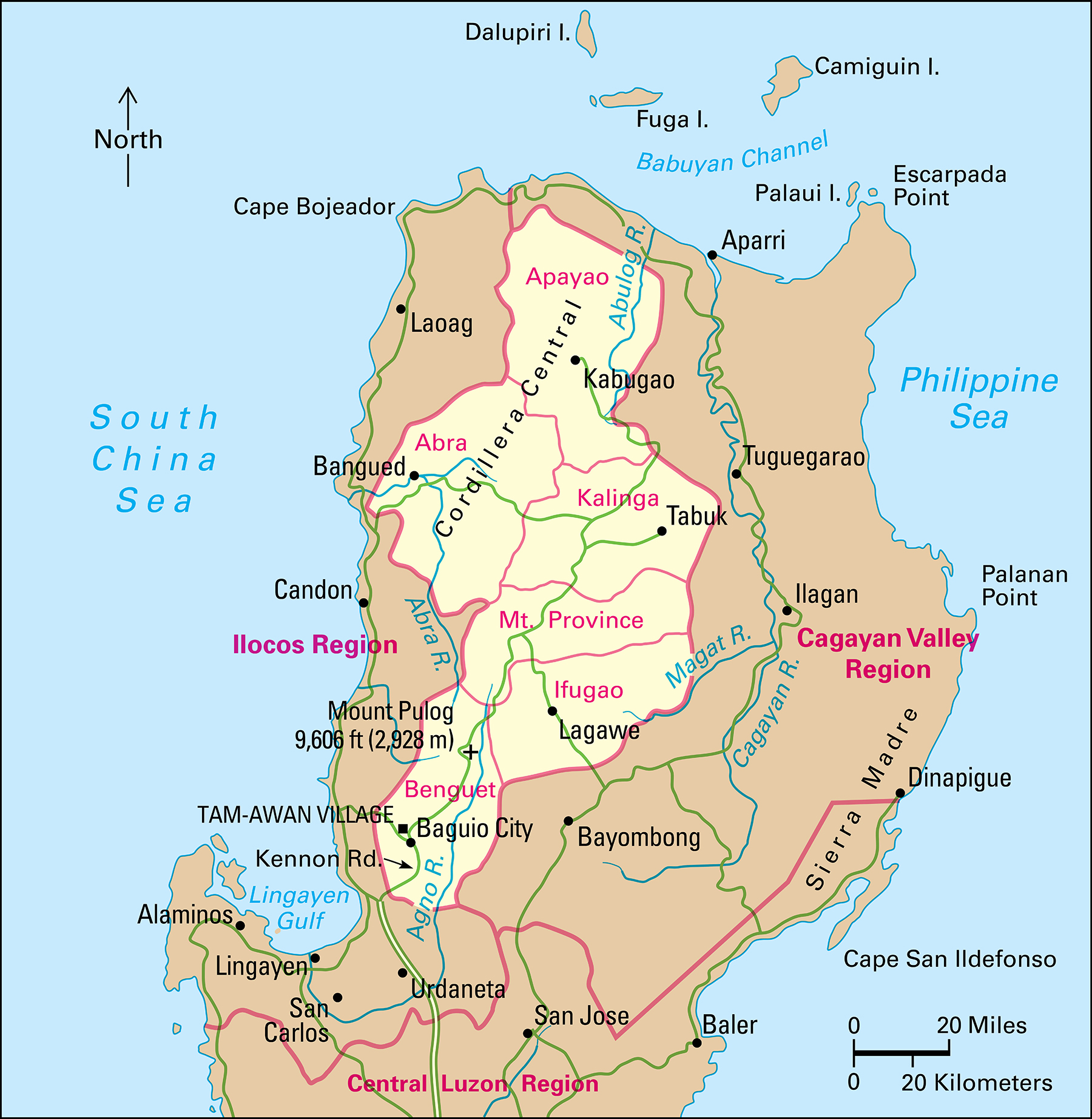
CAR consists of six provinces: (1) Abra, (2) Apayao, (3) Benguet, (4) Ifugao, (5) Kalinga, and (6) Mountain Province. The region has two major cities—Baguio City in Benguet and Tabuk in Kalinga. It also has dozens of municipalities (towns) and over 1,000 barangays (villages or neighborhoods).
People
Population.
The Cordillera Administrative Region is the least densely populated of the Philippine regions. The province of Benguet has the largest population, with almost half the region’s people living there. It is the region’s third smallest province by area and its most densely populated. Its regional center is the highly urbanized Baguio City. Baguio City, with an elevation reaching about 5,200 feet (1,600 meters), ranks as the highest major city in the Philippines.
Ancestry.
Most of the people who live in CAR, like nearly all Filipinos, are of Malay ancestry and related to the Malay peoples of Indonesia and Malaysia. Their ancestors have lived in the islands of the Philippines for thousands of years.
CAR is home to the Igorot, a collective name used for many Indigenous groups in the area. About one-third of the country’s Indigenous population lives in CAR. In the Philippines, the term Indigenous refers to groups that were never fully under the control of the Spanish colonists who settled the Philippines beginning in the 1500’s. The greater independence of these groups helped them preserve more of their traditional culture.
Language.
Most of the people of CAR speak Filipino (a variation of the Philippine language Tagalog), English, and Ilocano. Filipino and English are the two national languages. Almost two-fifths of households speak Ilocano, the third most spoken native Philippine language. People also speak languages from such Indigenous language groups as Bontoc, Ibaloi, Ifugao, Isneg, Kalinga, and Kankanaey. Many villages have their own dialects. The region’s diversity of languages results in part from its mountainous terrain, which limited communication among various groups.
Religion.
Roman Catholics make up the majority of the population. Most other people are Protestant Christians. Traditional, pre-Christian religions characterized by the worship of nature spirits have survived among some highland tribal groups.
Culture and attractions.
The preservation of early Philippine cultural traditions is especially noted among the large Indigenous population in CAR. For example, tattooing has served as a rite of passage among many Indigenous groups. Batok—the tattooing of thick black ink designs—remains a thousand-year-old tradition in the region. Batok is a technique in which a thorn is attached to a stick and dipped in ink made from soot. The thorn is rapidly tapped into the skin with a mallet. Different tribes use different instruments. The full chest and arms are often covered in patterns of curving and straight lines. In Ifugao, a man might have his arms, chest, legs, neck, and shoulders tattooed. In Kalinga, each village had a mambabatok (master tattooist), called upon to honor such milestones as a young woman’s coming of age. The ginayaman (centipede) is a traditional tattoo to be inked in preparation for battle. The ginawang (eagle) could be inked to mark a successful hunt.
Basket making remains an important cultural tradition among Indigenous tribal peoples of the region. In many groups, including the Ifugao, both men and women weave baskets, but only men weave them among the Kalinga. The baskets are made for use in harvesting, hunting, fishing, and even carrying lunches. Weavers make backpacks, baskets, and chicken coops from bamboo, rattan, leaves, and palm fibers. Women traditionally used baskets called balyags for harvesting sweet potatoes. The balyag rests along the woman’s back, held by a strap across her forehead. Woven hats and capes protect the wearer from sun and rain. The tudung serves as both a carrying basket and rain cape. It is made from pandanus tree leaves and rattan. Woven leaves and palm fibers help to waterproof tudungs and inabnūtan, backpacks carried by hunters. Soklong (basketry hats) serve as a status symbol.
Chicken and pigs are the most important traditional livestock in the region. Ubi are basketry chicken coops hung high above the ground at night to protect the chickens from predators. Iwus are ventilated storage baskets used to hold locusts, a local delicacy. Locusts are boiled or roasted and then dried in the sun to be eaten.
Other popular foods native to the region include Arabica coffee, made from beans grown at high altitudes, and etag (sliced pork cured in salt and then sun-dried or smoked). Rice beer plays an important part in agricultural celebrations and religious rituals. The beer is fermented on banana leaves and then kept in ceramic jars.
CAR is known for its strawberry farms, where residents and tourists pick the fruit during harvest season. Baguio City’s Tam-awan Village, a replica of a traditional village, is a popular tourist destination for viewing Indigenous art and community life.
CAR has national parks featuring waterfalls and caves. The region is known for its ancient rice-growing terraces. Ifugao is home to the Banaue Rice Terraces, a UNESCO World Heritage site. World Heritage sites are places of unique cultural or natural importance. The terraces were mostly constructed by hand more than 2,000 years ago. They were used by Indigenous people to grow crops. Similar terraces are still used today.
Education.
Philippine national law requires children from 5 to 17 years old to go to school, from kindergarten through the 12th grade. The Department of Education provides free primary and secondary education. There are also many private schools. Teachers in the public elementary schools conduct classes in the local language for the first few years and then introduce English and Filipino. Most of the private schools teach in English. The high schools and universities mostly use English.
There are several universities in CAR, including institutions in Tabuk and in each province. There are universities in Baguio City and elsewhere in Benguet, including La Trinidad.
Land and climate
Location and description.
The Cordillera Administrative Region is 7,652 square miles (19,818 square kilometers) in area. It lies in the northern central portion of the island of Luzon. Apayao is its largest province in size, followed by Abra, Kalinga, Benguet, Ifugao, and Mountain Province.
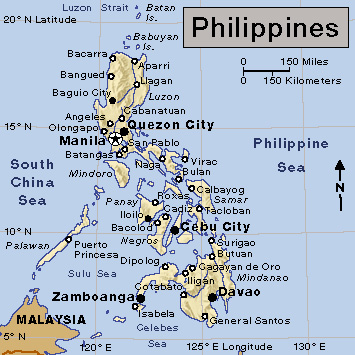
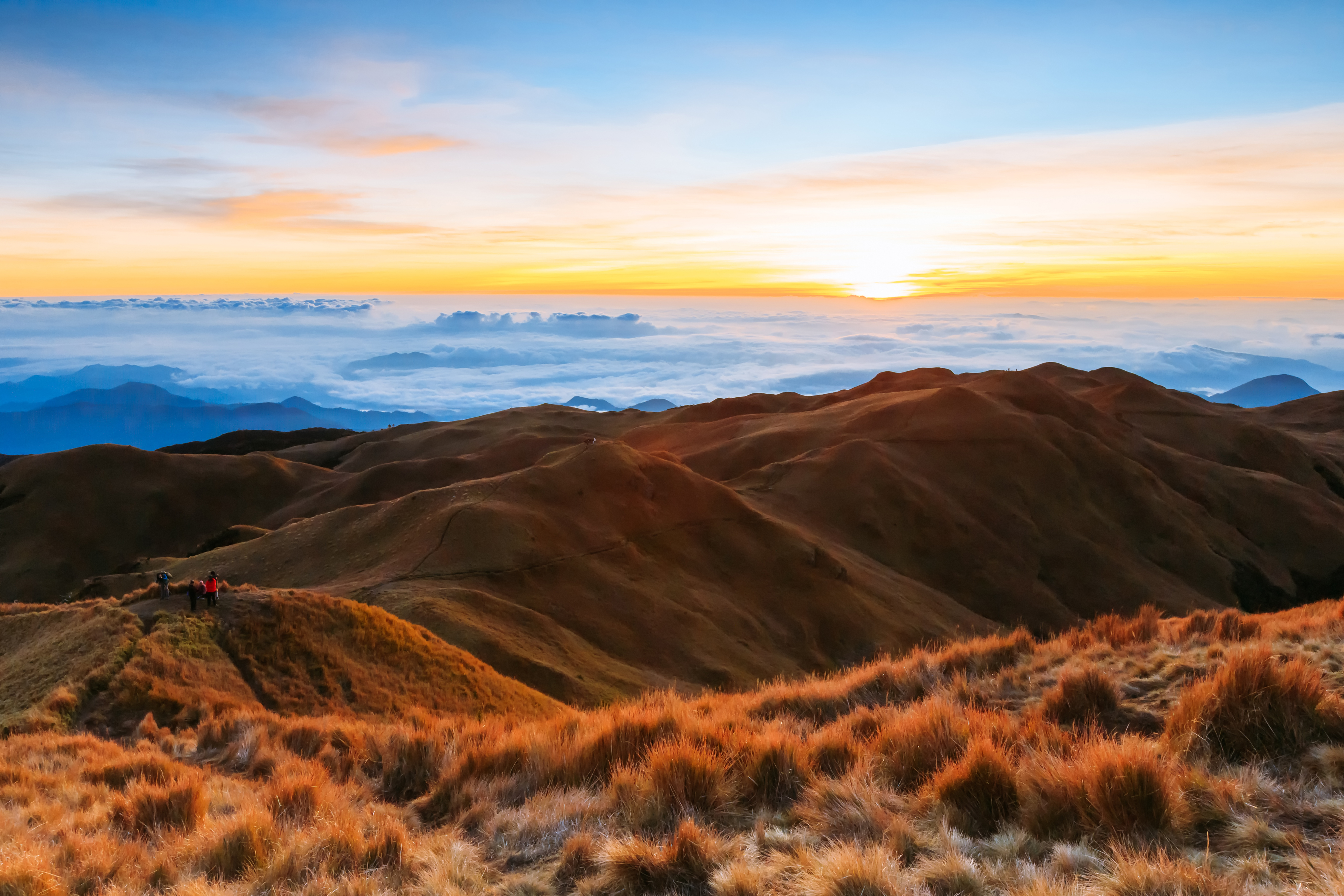
CAR is the only landlocked region of the Philippines. Its Cordillera Central is the largest mountain range in the Philippines and features Mount Pulag, the second highest mountain in the country at 9,606 feet (2,928 meters) above sea level. More than 70 percent of CAR’s land area has steep slopes. The Mountain Province is 83 percent mountainous, with much of the rest being hilly. It is known for its caves, cliffs, rivers, mountains, and waterfalls.
Luzon has many inactive volcanoes. Earthquakes, landslides, and other geologic hazards frequently strike the region because of its location on active fault lines. Steep slopes and heavy seasonal rains can lead to mudslides and flooding.
Rivers.
Nine major rivers originate in CAR. They are the (1) Abra, (2) Abulog, (3) Agno, (4) Amburayan, (5) Balili, (6) Bued, (7) Chico, (8) Ifugao, and (9) Magat rivers.
These rivers provide irrigation and hydroelectric power for the island. Hydroelectric power plants supply a significant amount of Luzon’s power. One such plant is in Bakun, Benguet, and another is at the Binga Dam in Itogon, Benguet. The San Roque Multi-Purpose Dam lies in CAR along the lower Agno River. It produces hydroelectric power and gathers water for irrigation. The dam’s construction displaced many Indigenous people. The dam became operational in 2003.
Climate.
The Philippines has a tropical climate with high humidity and rainfall. In CAR, the dry season runs from November to April. The rest of the year is the wet season. Typhoon season, from June to December, often brings damaging storms and flooding. More than 75 percent of CAR stands about 1,600 to 6,600 feet (500 to 2,000 meters) above sea level. The region’s elevation gives it a cool climate.
Economy
The Cordillera Administrative Region is rich in natural resources. Its economy depends on agriculture, forestry, and mining. Most of the region’s people work in the agriculture and service industries. CAR is known for growing coffee, rice, and strawberries. Its farmers also grow many highland vegetables and tropical fruits. The main exports of the region include woodcarvings and hand-woven materials. Few people work in manufacturing, mining, and construction, but these industries account for a large part of the region’s income. 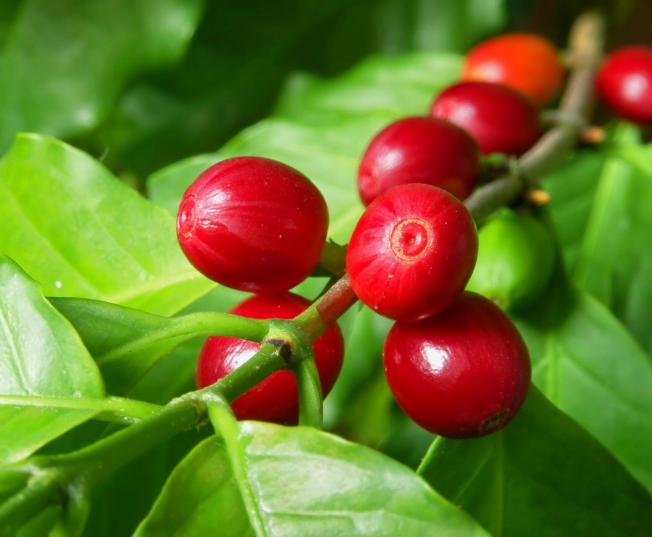
Agriculture
is important in each province. About half of the region’s workers are employed in agriculture. Leading crops include Baguio beans (string beans), cabbage, coffee, corn, eggplant, palay (unhusked rice), tobacco, and tomatoes. CAR is an important producer of such highland vegetables as broccoli, carrots, cauliflower, lettuce, and potatoes. Farmers also grow greens, peas, chayote (a type of squash, called sayote in the Philippines), and sweet potatoes and other root crops. Leading fruit crops include bananas, coconuts, and mangoes. Such tropical fruits as citrus fruits, durian, lanzones, mangosteen, pineapples, rambutan, and santol (also known as cotton fruit) are also grown throughout CAR. The province of Benguet is known for its strawberry production. Baguio City produces many types of flowers. 
Livestock are raised on grasslands. Important livestock include carabao, cattle, goats, and hogs. Carabao are a type of water buffalo. Poultry, including chickens and ducks, are also raised.
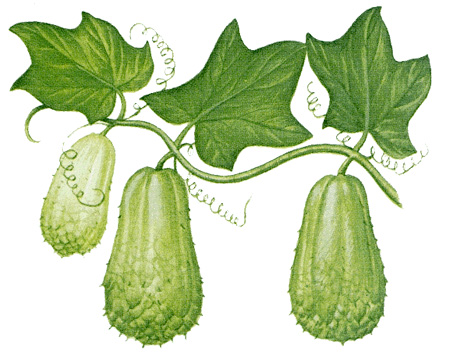
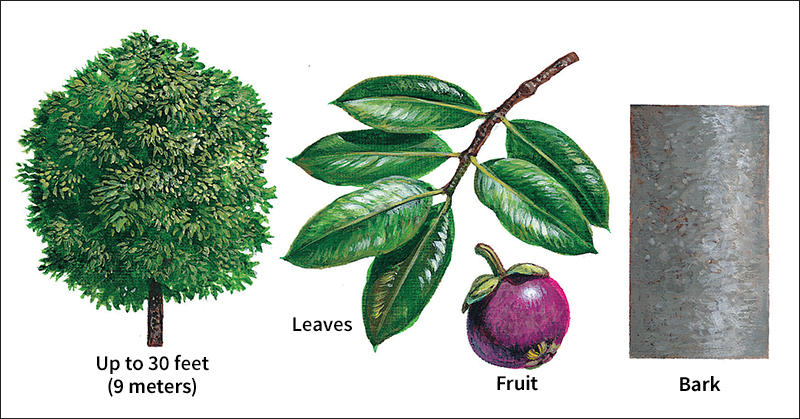
Fishing industry.
CAR has a small fishing industry. The industry consists mostly of aquaculture (fish farming)—raising tilapia in the mouths of rivers—with some inland fishing. Ifugao, which lies high in the Cordillera Central, is the largest fish-producing province.
Manufacturing
accounts for a small part of the region’s economy. CAR is known for its weaving and hand-crafted basketry. Bamboo and rattan are woven into bags, blankets, traditional costumes, fashion accessories, linens, purses, and tapestries. Other industries include food processing and rice milling. Many furniture products are made in Mountain Province from bamboo, pine, and steel. People also create woodcarvings and handicrafts.
Mining
ranks as an important regional industry. CAR is rich in mineral deposits and has profited from the production of copper, gold, and silver. The Baguio area is especially rich in deposits of copper and gold. 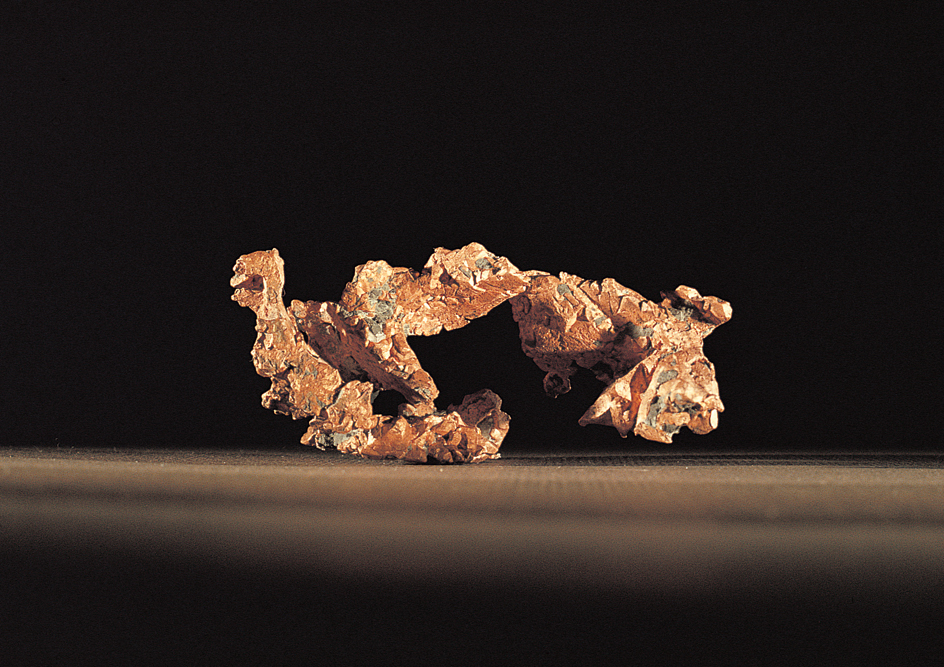
Service industries
account for about half of both the region’s employment and economic production. Tourism, a major industry in CAR, benefits the region’s hotels, restaurants, and stores. Tourism is the main industry of Baguio City. The city has many hotels to accommodate tourists, who visit during the summer to escape the heat of the lowlands. Many of the region’s people are also employed by banks, schools, and the government.
Transportation and communication.
The region’s high elevation and mountainous terrain make infrastructure and other physical development projects difficult. When the region was formally established in 1987, only 20 percent of its roads were paved. After decades of infrastructure improvements, most of the region’s roads are now paved. Baguio City has an airport. Regional newspapers published in CAR include Baguio Midland Courier, Baguio News, and Northern Dispatch Weekly.
Government
The Cordillera Administrative Region, like the other regions in the Philippines, has a regional council for administrative management and developmental planning. Provinces are the main units of local government. Every province has a governor, a vice governor, and an elected legislative body called a sangguniang panlalawigan. An elected mayor and council govern each city or municipality. A few major cities in the Philippines are governed independently of any province. Barangays are governed by elected barangay captains and councils.
Local governments are formally under the general supervision of the president. The people elect provincial, city, and municipal officials for three-year terms. These local officials may not serve more than three consecutive terms. Barangay officials serve a fixed term of office that is determined by law.
Every city has a court. Each municipality has a judge who serves as the local judicial officer. Judges hold office until they reach the age of 70 or until they become unable to carry out their official duties.
History
Early peoples in what is now CAR lived in small villages. They developed a wide variety of languages and cultures. Rice farming was central to the way of life in many areas.
During the 1600’s, Spanish settlers attempted to establish mining operations in the area, but European settlement remained limited until the 1800’s. Following Spain’s defeat in the Spanish-American War (1898), Spain ceded (surrendered) the Philippines to the United States. This event marked the start of greater assimilation (integration) of the Igorot and the area’s other mountain groups into the larger Philippine society.
In the early 1900’s, U.S. soldiers in the Philippines often traveled to Baguio City to escape the summer heat. Chinese, Filipino, and Japanese workers began building the Kennon Road in 1903, completing it in 1905. It was the first road connecting Baguio to the lowlands, in the Pangasinan province of the Ilocos Region. In 1909, Baguio was declared the nation’s second chartered city, after Manila. Baguio City became known as the “summer capital of the Philippines” for its cool temperatures.
During World War II (1939-1945), Japanese forces invaded the Philippines in 1941 and soon captured the islands. After the war ended, the formal surrender of the Japanese forces of occupation in the Philippines to the United States Army took place in Bagiuo City on Sept. 3, 1945. The Philippines became an independent nation in 1946.
During the 1970’s, government plans to build large hydroelectric dams on the Chico River threatened to displace thousands of Indigenous people in the Cordillera. Logging projects also endangered ancestral lands. These programs and harsh government measures to suppress opposition to them united many Indigenous groups in the area against the regime of President Ferdinand E. Marcos. After Corazon C. Aquino became president in 1986, her government negotiated a settlement. In July 1987, Aquino signed an executive order to form the Cordillera Administrative Region from areas that had been part of the Ilocos and Cagayan Valley regions. The 1987 Philippine Constitution provided for CAR to become an autonomous region with greater powers over its own affairs than most regions possessed, if the people in its provinces voted to approve the change. In 1990 and 1998, however, the majority of the people voted to keep the region’s present status.
On July 16, 1990, Baguio City was severely damaged by an earthquake. Several buildings were destroyed, but the area was later rebuilt.
